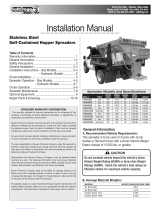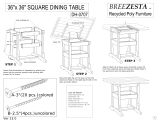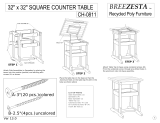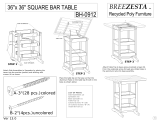Page is loading ...

April 1, 2017
Lit. No. 94634, Rev. 01
Regular and High Capacity
Hopper Spreader
Installation Instructions
These Installation Instructions are for WESTERN® Regular and High Capacity
Hopper Spreaders with serial numbers 5503–6998.
Western Products, PO Box 245038, Milwaukee, WI 53224‑9538 • www.westernplows.com
A DIVISION OF DOUGLAS DYNAMICS, LLC
CAUTION
Read this document before installing
or operating the spreader.


Lit. No. 94634, Rev. 01 3 April 1, 2017
SAFETY
WARNING/CAUTION LABELS
Become familiar with and inform users about the
warning and caution labels on the spreader.
NOTE: If labels are missing or cannot be read, see
your sales outlet.
SAFETY DEFINITIONS
NOTE: Indicates a situation or action that can lead
to damage to your spreader and vehicle or other
property. Other useful information can also be
described.
CAUTION
Indicates a potentially hazardous situation
that, if not avoided, may result in minor or
moderate injury. It may also be used to alert
against unsafe practices.
WARNING
Indicates a potentially hazardous situation
that, if not avoided, could result in death or
serious personal injury.

Lit. No. 94634, Rev. 01 4 April 1, 2017
SAFETY
SAFETY PRECAUTIONS
Improper installation and operation could cause
personal injury and/or equipment and property
damage. Read and understand labels and the
Owner's Manual before installing, operating, or
making adjustments.
WARNING
• Driver to keep bystanders minimum of
25 feet away from operating spreader.
• Before working with the spreader, secure all
loose-tting clothing and unrestrained hair.
• Before operating the spreader, verify that all
safety guards are in place.
• Before servicing the spreader, wait for
conveyor, auger, and spinner to stop.
• Do not climb into or ride on spreader.
WARNING
Do not install the control for this product in
the deployment path of an air bag. Refer to
vehicle manufacturer's manual for air bag
deployment area(s).
CAUTION
If rear directional, CHMSL light, or brake
stoplights are obstructed by the spreader, the
lights shall be relocated, or auxiliary directional
or brake stoplights shall be installed.
CAUTION
Disconnect electric and/or hydraulic power
and tag out if required before servicing or
performing maintenance.
NOTE: Lubricate grease ttings after each use.
Use a good quality multipurpose grease.
FUSES
The electrical system contains several blade-style
automotive fuses. If a problem should occur and
fuse replacement is necessary, the replacement
fuse must be of the same type and amperage rating
as the original. Installing a fuse with a higher rating
can damage the system and could start a re. Fuse
Replacement, including fuse ratings and locations,
is located in the Maintenance section of the Owner's
Manual.
WARNING
Overloading could result in an
accident or damage. Do not exceed
GVWR or GAWR ratings as found
on the driver‑side vehicle door
cornerpost. See Loading section to determine
maximum volumes of spreading material.
CAUTION
DO NOT leave unused material in
hopper. Material can freeze or solidify,
causing unit to not work properly.
Empty and clean after each use.
CAUTION
During the hopper installation we recommend
the addition of an OSHA compliant Backup
Alarm. This alarm is required for OSHA
governed employers.
WARNING
Hydraulic uid under pressure can
cause skin injection injury. If you are
injured by hydraulic uid, get medical
attention immediately.
CAUTION
• Do not operate a spreader in need of
maintenance.
• Before operating the spreader, reassemble
any parts or hardware removed for cleaning
or adjusting.
• Before operating the spreader, remove
materials such as cleaning rags, brushes,
and hand tools from the spreader.
• Before operating the spreader, read the
engine owner's manual, if so equipped.
• While operating the spreader, use auxiliary
warning lights, except when prohibited by law.
• Tighten all fasteners according to the
Torque Chart. Refer to Torque Chart for the
recommended torque values.

Lit. No. 94634, Rev. 01 5 April 1, 2017
SAFETY
PERSONAL SAFETY
• Remove ignition key and put the vehicle in park or
in gear to prevent others from starting the vehicle
during installation or service.
• Wear only snug-tting clothing while working on
your vehicle or spreader.
• Do not wear jewelry or a necktie, and secure long
hair.
• Wear safety goggles to protect your eyes from
battery acid, gasoline, dirt, and dust.
• Avoid touching hot surfaces such as the engine,
radiator, hoses, and exhaust pipes.
• Always have a re extinguisher rated BC handy,
for ammable liquids and electrical res.
FIRE AND EXPLOSION
Be careful when using gasoline. Do not use gasoline
to clean parts. Store only in approved containers away
from sources of heat or ame.
CELL PHONES
A driver's rst responsibility is the safe operation of
the vehicle. The most important thing you can do
to prevent a crash is to avoid distractions and pay
attention to the road. Wait until it is safe to operate
Mobile Communication Equipment such as cell phones,
text messaging devices, pagers, or two-way radios.
WARNING
Gasoline is highly ammable and gasoline
vapor is explosive. Never smoke while
working on vehicle. Keep all open ames
away from gasoline tank and lines. Wipe up
any spilled gasoline immediately.
VENTILATION
BATTERY SAFETY
NOISE
Airborne noise emission during use is below 70 dB(A)
for the spreader operator.
VIBRATION
Operating spreader vibration does not exceed 2.5 m/s2
to the hand-arm or 0.5 m/s2 to the whole body.
CAUTION
Batteries normally produce explosive gases
which can cause personal injury. Therefore,
do not allow ames, sparks, or lit tobacco
to come near the battery. When charging or
working near a battery, always cover your
face and protect your eyes, and also provide
ventilation.
• Batteries contain sulfuric acid, which burns
skin, eyes, and clothing.
• Disconnect the battery before removing or
replacing any electrical components.
WARNING
Vehicle exhaust contains lethal fumes.
Breathing these fumes, even in low
concentrations, can cause death. Never
operate a vehicle in an enclosed area without
venting exhaust to the outside.

Lit. No. 94634, Rev. 01 6 April 1, 2017
SAFETY
TORQUE CHART
1/4-20 10
91
54
1/4-28 12
11
71
5/16-1
81
50 212
5/16-2
41
70 240
3/8-16 269 376
3/8-24 29
74
20
7/16-1442
96
06
7/16-20
9/16-12
9/16-18
5/8-11
5/8-18
3/4-10
3/4-16
7/8-9
7/8-14 47
46
69
64
49
091-8
1-12 70
49
95
1/2-13
1/2-20
11.9
13.7
24.6
27.3
43.6
26.9
53.3
93
148
49.4
69.8
77.9
106.4
120.0
8.4
9.7
17.4
19.2
30.8
35.0
49.4
55.2
75.3
85.0
M6 x 1.00
M12 x 1.75
M8 x 1.25
M14 x 2.00
M10 x 1.50
M27 x 3.00
M22 x 2.50
M30 x 3.50
M24 x 3.00
M20 x 2.5011.1
19.5
38.5
67
107
7.7
613
778
1139
1545
450
428
562
796
1117
M33 x 3.50
M36 x 4.00
2101
2701
1468
1952
325
M16 x 2.00 231167
M18 x 2.50 318222
Recommended Fastener Torque Chart
Size Size
Torque (ft-lb)
Grade
5
Grade
8
Metric Fasteners Class 8.8 and 10.9
These torque values apply to fasteners
except those noted in the instructions.
Torque (ft-lb)
Grade
5
Grade
8
Size Size
Torque (ft-lb)
Class
8.8
Class
10.9
Torque (ft-lb)
Class
8.8
Class
10.9
Inch Fasteners Grade 5 and Grade 8
CAUTION
Read instructions before assembling.
Fasteners should be nger tight until
instructed to tighten according to the Torque
Chart. Use standard methods and practices
when attaching spreader, including proper
personal protective safety equipment.

Lit. No. 94634, Rev. 01 7 April 1, 2017
Regular Capacity Load Volume
LOADING
These instructions cover vehicles which have been
recommended for carrying the hopper spreader.
Please see your local dealer for proper vehicle
applications.
CERTIFICATION
WARNING
Overloading could result in an accident or
damage. Do not exceed GVWR or GAWR as
found on the driver‑side cornerpost of vehicle.
WARNING
New untitled vehicle installation of a spreader
requires National Highway Trafc Safety
Administration altered vehicle certication
labeling. Installer to verify that struck load of
snow or ice control material does not exceed
GVWR or GAWR rating label and complies
with FMVSS.
CAUTION
Read and adhere to manufacturer's
ice‑control material package
labeling, including Material Safety
Data Sheet requirements.
MATERIAL WEIGHTS
Density
Material (lb/ft3)(lb/yd3)(kg/m3)
Salt 80 2160 1282
Sand 100 2700 1602
Material densities are approximate and are based on dry,
loose material. It is the responsibility of the operator to
know the weight of the material to be spread and the vehicle
carrying capacity.
High Capacity Load Volume
19"
27"
12"
0.5 yd³
1.0 yd³
1.8 yd³
8' Spreader7' Spreader
0.44 yd³
0.88 yd³
1.
6 yd³
24"
32.5"
12"
0.7 yd³
2.0 yd³
3.3 yd³
10' Spreader8' Spreader
0.5 yd³
1.6 yd³
2.6 yd³

Lit. No. 94634, Rev. 01 8 April 1, 2017
Mounting the Spreader onto the Vehicle
NOTE: Periodically throughout the snow and ice
control season, verify that mounting devices are
secure.
1. Remove the tailgate from the truck.
2. Lift the spreader. See appropriate instructions
below.
Regular Capacity: Lift spreader by hooking the loop
located on rear cross channel inside hopper.
NOTE: The loop is located at the approximate
balance point of the spreader. The balance point
may vary with engine uid levels, battery, top
screen, or residual material in hopper.
MOUNTING THE SPREADER
High Capacity: Lift spreader by hooking all four loops
located at the corners of the hopper.
CAUTION
Before lifting, verify hopper is empty of
material. The lifting device must be able to
support the spreader's weight.
Lifting Loop
Loops

Lit. No. 94634, Rev. 01 9 April 1, 2017
6. Bolt the spreader to the vehicle frame through the
lengths of lumber using the holes located at each
lower support leg. Use 1/2" hardware as required
by vehicle application. If 2 x 4s are not directly
over the truck box supports, the truck bed must
be braced to the frame to prevent buckling or
deforming the truck bed.
NOTE: Pay special attention when drilling or
clamping dissimilar metals to aluminum bodies.
Galvanic corrosion can occur if not handled
properly. Contact vehicle manufacturer for
recommended attachment practices.
MOUNTING THE SPREADER
3. Before lowering the spreader, place lengths of
lumber (2" x 4" x 48" minimum) under the side
ribs. By elevating the spreader off of the vehicle,
it is easier to remove excess material that
accumulates under the spreader.
4. Center the spreader on the vehicle with the end
of the spreader sills 11" to the rear of the nearest
vertical obstructions (bumper, trailer hitch, etc.).
5. Measure the distance from the front of the truck
bed to the sills and make a spacer to place
between the bed and the rails.
Fit
to
Veh.
11.5"
Min.
Height
Fit to vehicle.
(d)
(w)
WARNING
Spreader shall be bolted to vehicle frame.
Do not rely on the tie‑down chains or straps
alone to hold spreader in vehicle.
Ends of Sills
Spacer
Side Ribs
2" x 4" Boards

Lit. No. 94634, Rev. 01 10 April 1, 2017
CHUTE ATTACHMENT INSTRUCTIONS
Chute Assembly
1. High Capacity 31" Chute Only: Remove the
access panel on the back of the chute housing
2. Remove the sprocket guard from the engine base.
3. Loosely attach the chute assembly using four
3/8" x 1" carriage bolts, at washers, lock
washers, and nuts with the heads of the fasteners
on the inside of the chute.
4. Push the chute assembly toward the front of the
vehicle. DO NOT tighten the bolts at this time.
5. Install the roller chain between the spinner shaft
sprocket and the gear case sprocket with the
master link.
6. Verify the sprockets are in line and the set screws
are tight.
7. To adjust roller chain tension, loosen the spinner
shaft bearing bolts and move the spinner shaft
away from the gear case. Correct chain tension
allows a 5/16" deection midway between the
sprockets. Make sure the spinner shaft is vertical
and the sprockets are lined up before retightening
the fasteners.
8. Additional chain tension may be applied by pulling
the chute assembly toward the rear.
9. Tighten all fasteners according to the torque chart.
10. Install the chain guard using 1/4" x 3/4" hex cap
screws, lock washers, and nuts.
11. Install the sprocket guard using 1/4" x 3/4" hex cap
screws, lock washers, and nuts.
12. High Capacity 31" Chute Only: Secure the
access panel onto the chute housing.
CAUTION
Overtightening the roller chains may damage
the bearings on the gear case, the engine,
and/or the spinner shaft. Overtightening will
also shorten the life of the roller chain and of
the sprockets.
5/16" Deflection
Chute
Mounting
Holes
Spinner
Shaft
Sprocket
Roller Chain
Chain
Guard
Sprocket Guard

Lit. No. 94634, Rev. 01 11 April 1, 2017
Vehicle Harness Installation
All spreaders are shipped from the factory with the
spreader harness wired to the engine, clutch, and
electric throttle.
NOTE: Use dielectric grease on all electrical
connections.
1. Attach the spreader harness to the side of the
spreader using pre-drilled holes, #6 clamp loops,
and self tapping screws.
2. Plug the vehicle harness into the spreader
harness.
3. Lay out a path for routing the vehicle harness
into the cab of the truck. Make sure the vehicle
harness avoids any hot or moving parts of the
truck. Routing will vary from truck to truck.
4. Identify a convenient location for the cab control
that can be reached by the harnesses and wiring.
5. Drill a 5/8" hole in the oor so that the vehicle
harness can reach the desired cab control
location.
6. Insert the rubber grommet into the hole.
7. Route the harness to the desired location.
8. Secure the vehicle harness to the truck. Verify that
the harness cannot drop onto the road when it is
disconnected from the spreader.
WIRING INSTRUCTIONS
Wiring Instructions
To properly wire the hopper spreader, please adhere
to the following recommended installation sequence.
1. Install either the Spreader or Vehicle Battery Kit
per the instructions included with the kit.
2. Install the vehicle harness included with the
spreader per the following instructions.
3. Install the cab control per the instructions included
with the cab control.
CAUTION
Before drilling any holes, check both sides
of the material for any wires, fuel lines, fuel
tanks, etc., that may be damaged by drilling.

Lit. No. 94634, Rev. 01 12 April 1, 2017
1. Install the plug cover as shown.
2. Position the legs of the hook over the spreader
harness.
3. Twist the hook to spread the wire.
4. Rotate the hook and push over the spreader
harness.
5. Squeeze the legs of the hook together and slide
the hook over the spreader harness plug.
HARNESS PLUG AND HOOK INSTRUCTIONS
S
tep 2
Step 3
Step 4
Step 5
Plug Cover
Hook Legs
Spreader
Harness Plug
Vehicle
Harness Plug
6. After connecting the spreader harness plug with
the vehicle harness plug, secure the plug cover
into the legs of the hook.

Lit. No. 94634, Rev. 01 13 April 1, 2017
Choke Adjustment Procedure
1. The choke linkage and choke adjustment screw is
shipped from the factory with the choke buttery
set to 75% fully closed choke.
2. With the choke set at 100% the engine will not
stay running in the choked position. This position
is for extremely cold conditions. Throttle linkage
travel from 0% to 100% choke is 3/16". Four and
one-half turns of the choke adjustment screw
(clockwise when viewed from above the engine)
will take the maximum choke setting from fully
closed to fully open (no choking at all).
3. To adjust your choke setting, loosen the
adjustment retainer screw and rotate the choke
adjustment screw clockwise one full turn (scratch
a mark on the knob to indicate position). This will
generally allow the engine to run very roughly with
the throttle linkage at maximum choke. This is
approximately the equivalent of 75% fully closed
choke. (This is the factory setting.)
4. Additional adjustments can be made by 1/4 turn
increments until you reach the desired start/run in
choke setting of your preference/need.
Choke Buttery
Choke Adjustment Screw
Retainer Screw
3/16" Max.
Adjustment
100%
0%
CHOKE ADJUSTMENT PROCEDURE

Lit. No. 94634, Rev. 01 14 April 1, 2017
HYDRAULIC UNIT INSTALLATION INSTRUCTIONS
Cab Control Valve Installation
1. With the seat fully forward, select a suitable
location to mount the cab control valve allowing for
the operator to adjust the control and to turn it ON
and OFF.
2. Check for clearance with ALL controls in the cab.
3. Under the cab, check for interference with
transmission, etc.
4. Check to see that the cab control valve location
does not interfere with entering or leaving cab.
5. Fabricate a bracket to mount cab control valve in
selected location.
6. Insert a grommet into all holes drilled for this
installation.
7. Mount valve and plumb pump and motor to valve.
Plumb Port "T" to reservoir, Port "P" to pressure
side of pump, and Port "REG" of the valve to Port
"B" of the gear box motor.
8. Check machine for proper rotation of drive shafts
and hydraulic leaks.
Hydraulic Unit Installation
Recommended sequence of installation is as follows:
1. Pump (not provided).
2. Install hydraulic reservoir.
3. Install cab control valve (optional).
4. Install hydraulic hoses (not provided).
5. Fill hydraulic reservoir and check system.
Pump
Because of the wide range of possible installations
of this hopper spreader, no pump is supplied with the
unit. If your truck does not have a pump suitable to
your application, one may be purchased from a local
truck equipment supplier. This pump should produce
9 GPM at 1,500 psi at normal operating speed and
have 1" NPT suction and discharge ports.
Hydraulic Reservoir Installation
Position the reservoir outlet as high, or higher than,
the pump inlet. Keep the hose distance as short as
possible. (Reservoir used should have a capacity of
1-1/2 to 2 times the pump maximum ow rate in GPM.)
Port A
Port B
FLOW
DIRECTION
Hydraulic Motor Plumbing

Lit. No. 94634, Rev. 01 15 April 1, 2017
Final Checklist
Verify correct engine oil level. (See engine
manufacturer's Owner's Manual.)
Verify the gear case oil level is level with the ll
hole.
Verify correct engine-to-clutch sprocket alignment
and chain tension.
Verify correct gear case to spinner shaft sprocket
alignment and chain tension.
Verify correct conveyor chain tension.
Verify the sprocket set screws are tight.
Verify dielectric grease is applied to all electrical
connections.
Verify wire harnesses are properly secured away
from hot or moving parts.
Verify vehicle harness cannot drop down below
the truck bed when the spreader is removed from
the truck.
Verify proper choke setting and choke light
operation. See Choke Adjustment Procedure.
Chains
Check engine to electric clutch roller chain tension.
Correct tension allows 5/16" deection midway
between the sprockets.
To increase spinner belt tension:
Loosen the four (4) engine mount to engine base
hardware and pull the engine away from the electric
clutch. Re-tighten the mounting hardware.
Check the conveyor chain tension. To check the
tension, measure in 20"–24" from the end of the sills.
Push up on the chain with your hand. The conveyor
chain should lift 1"–3" off the conveyor chain guide or
cross angles.
To increase chain tension:
Use the two 5/8" x 6" take-up bolts at the front of the
spreader to adjust conveyor chain tension. Turn both
bolts equal amounts to ensure the tension is equally
distributed across both sides of the conveyor chain.
Conveyor
Chain
Rear Edge
of Sill
1"–3"
20"–24"
5/16" Deflection
FINAL ADJUSTMENTS
CAUTION
Overtightening the roller chains may damage
the bearings on the gear case, the engine,
and/or the spinner shaft. Overtightening will
also shorten the life of the roller chain and of
the sprockets.

A DIVISION OF DOUGLAS DYNAMICS, LLC
Western Products
PO Box 245038
Milwaukee, WI 53224-9538
www.westernplows.com
Lit. No. 94634, Rev. 01 April 1, 2017
Western Products reserves the right under its product improvement policy to change construction or design details and furnish equipment
when so altered without reference to illustrations or specications used. Western Products or the vehicle manufacturer may require or
recommend optional equipment for spreaders. Do not exceed vehicle ratings with a spreader. Western Products offers a limited warranty for
all spreaders and accessories. See separately printed page for this important information. The following are registered (®) or unregistered (™)
trademarks of Douglas Dynamics, LLC: WESTERN®.
Printed in U.S.A.
/







